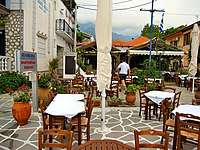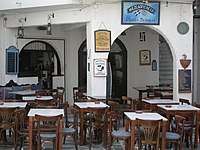Greek restaurant
A Greek restaurant is a restaurant that specializes in Greek cuisine.[1] In the United States they tend to be a different affair, varying in types of service, cuisine, menu offerings, table settings, and seating arrangements.[1] Their menu may also feature dishes from other cuisines.
By type

Estiatório
The estiatório (plural estiatória) is a type of modest restaurant in Greece.[2] It has been described as "something of a vanishing breed."[3] This form of eatery was more active during the early 1900s. An estiatório serves dishes such as casseroles, meat and game stews, baked meat and fish, macaroni pie, and mayirefta in the form of moussaka.[3] Estiatória serve dishes cooked in the oven called magerefta. In addition, they can have grilled-to-order foods called tis oras, fish, appetizers (mezedes), and salads.
Gyrádiko (Souvlatzidiko)
Gyrádiko (plural girádika) restaurants serve the popular Greek dish gyros. In Greece, gyros are typically prepared using spiced ground pork shoulder meat on a pita with tzatziki sauce, while in the United States, they are commonly prepared with ground lamb sliced from a vertical rotisserie spit.
Souvlatzidiko restaurants serve the famous Greek dish souvlaki.[4] Souvlaki is prepared using cubed pork or chicken meat that is cooked like a kebab.[4]
Mezedopoleío
Meze restaurants are known as mezedopoleío (singular)[4] or mezedopoleía (plural) and serve appetizers known as meze or orektiko (plural mezedes/orektika) to complement beverages. Some meze restaurants do not offer a menu and serve whatever has been prepared that day. Meze restaurants are common in Greece, especially Psiri, Athens, and are regarded as the most expensive Greek Restaurant.
Ouzerí
Establishments known as ouzerí are a type of café that serve drinks such as ouzo or tsipouro. They are similar to mezedopoleio restaurants and also provide similar food and service. A tsipourádiko is a "local variant of an ouzerí."[5]
Taverna
Tavernas, originating in Greece, are typically medium-sized restaurants with affordable pricing[4] that serve a variety of Greek dishes, foods, and beverages. Locations with outdoor seating are popular during the summer season.
- Greek restaurants by type
.jpg) A gyro restaurant (gyrádiko) in Latin Quarter, Paris
A gyro restaurant (gyrádiko) in Latin Quarter, Paris- A gyrádiko in Cyprus (left corner)


 Mezedopoleio in Naxos
Mezedopoleio in Naxos
By country
Greece
 |
| Greek cuisine |
|---|
| History |
| Regional |
| Influences |
|
|
In many Greek restaurants, it is not considered impolite for guests to enter the kitchen to see what is cooked before ordering; however, this is not typical in fine dining and hotel restaurants.[2] After visiting the kitchen, a waiter will be notified of guests' choices.[2] Table service is usually relaxed and laid-back and patrons may need to flag down or wait for staff to order and request items.[2] Wine is commonly consumed during lunch and dinner.[2]
United States
In the U.S., Greek restaurants provide authentic Greek cuisine and dining customs.[6] They may also offer dishes from other cuisines. Immigrants from Greece have opened many Greek restaurants in the U.S., some of which began due to new health codes during the early 20th century that limited or restricted food carts.[6] Per the restrictions during this time, people opened Greek restaurants instead of operating food carts.[6] Additionally, many Greek confectioneries and sweet shop businesses declined during this period due to an increase in manufactured candies and sweets.[6] Many of these companies transformed their businesses into lunchrooms, and later, restaurants.[6]

During the early 1900s, some Greek immigrant restaurants expanded their operations into chain restaurants.[6] At the time, Greek restaurant chains included (by location):[6]
- Chicago – The Katsivalis (Teddy) Family owned 15 Restaurants and 6 Hotels with Restaurants in them.
- New York – Foltis, Stavrakas, Litzotakis
- North Carolina, South Carolina, and Virginia: Lambropoulos
In 1913, there were "several hundred Greek-owned lunchrooms and restaurants in Chicago."[7]
It is estimated that approximately 7,000 Greek restaurants existed in the U.S. by the beginning of the Great Depression in 1929.[6] However, many U.S. Greek restaurants went out of business due to the Great Depression. [6] As a result, more patrons could not afford to eat out in restaurants during this time.[6] In addition, competition rose due to an increase in affordably-priced lunch counters opening in various types of stores, such as drug stores and department stores.[6]
During the 1950s and 1960s, the number of Greek restaurants increased, and by the 1970s, they were considered a significant pillar in the U.S. restaurant landscape.[6]
Cuisine
Appetizers and light meals
A tavérna or estiatório may offer a meze as an orektikó. Many restaurants offer their house pikilía, a platter with a variety of various mezedes that can be served immediately to customers looking for a quick or light meal. Krasomezédhes (literally "wine-meze") are mezedes that go well with wine; ouzomezédhes are mezedes that go with ouzo, a Greek beverage. Psomi oretiko is a bread appetizer that is common in Greek restaurants.[8]
Main courses
In Greece, the main courses may be ordered directly from the kitchen, a menu board[2] or physical menus. In coastal Greek restaurants, fish dishes may be weighed and sold by the kilogram, which occurs before cooking.[2] Frozen fish is sometimes used, which may be described on menus as katepsigmenos.[2] Seafood dishes that are staples include swordfish, octopus, squid, sardines, and prawns.[2]
Beverages
Most Greek restaurants will have traditional water, sparkling water, soda, wine and beer. Some restaurants will also have specialty cocktails and wine. "Greece is one of the oldest wine-producing regions in the world and among the first wine-producing territories in Europe."[9] Some restaurants may also serve Ouzo, a dry anise-flavored aperitif that is widely consumed in Greece and Cyprus. It is made from rectified spirits that have undergone a process of distillation and flavoring.[10] It is a tradition to have Ouzo in authentic Greek restaurants as an aperitif, served in a shot glass, and deeply chilled before the meal is started.[10]
- Greek restaurant cuisine
.jpg) Grilled vegetables at a Greek and Santorinian restaurant
Grilled vegetables at a Greek and Santorinian restaurant.jpg) Fried squid at a Greek restaurant
Fried squid at a Greek restaurant.jpg) Salted cod with garlic sauce, a traditional Greek dish for the day of the Annunciation,[11] served at a Greek restaurant
Salted cod with garlic sauce, a traditional Greek dish for the day of the Annunciation,[11] served at a Greek restaurant
Gallery
 Depiction of a Greek road sign signifying dining in an area
Depiction of a Greek road sign signifying dining in an area Restaurants in Nafplio
Restaurants in Nafplio.jpg) Interior of a taverna in Kos
Interior of a taverna in Kos- A fast casual Greek restaurant
- Restaurants in Thessaloniki
See also
- Greek food products
- Greek pizza
- List of Greek restaurants
- Mediterranean cuisine
- Types of restaurant
Notes
- Halper 2001, p. 9A-670 Archived 2016-12-27 at the Wayback Machine.
- Michelin Travel & Lifestyle 2012 Archived 2016-04-08 at the Wayback Machine.
- Garvey & Fisher 2009, p. 67.
- Albala 2011, p. 168.
- Dubin 2011, p. 293.
- Moskos & Moskos 2013, pp. 154–158 Archived 2016-06-24 at the Wayback Machine.
- Moskos & Moskos 2013, p. 31 Archived 2016-04-26 at the Wayback Machine.
- Sarianides 2004, p. 28.
- "Greek wine", Wikipedia, 2019-09-25, retrieved 2019-10-04
- "Ouzo", Wikipedia, 2019-09-24, retrieved 2019-10-04
- Traditional Festivals (M-Z), p. 12.
References
- Albala, K. (2011). Food Cultures of the World Encyclopedia. Food Cultures of the World Encyclopedia. Greenwood. ISBN 978-0-313-37626-9.
- Dubin, M. (2011). DK Eyewitness Travel Guide: Greece Athens & the Mainland: Greece Athens & the Mainland. Eyewitness Travel Guides. DK Publishing. ISBN 978-0-7566-8434-1.
- Garvey, G.; Fisher, J. (2009). The Rough Guide to Greek Islands. Rough Guide to... Rough Guides. ISBN 978-1-4053-8412-4.
- Halper, E.B. (2001). Shopping Center and Store Leases. Real estate series. Law Journal Seminars-Press. ISBN 978-1-58852-003-6.
- Michelin (2012). Michelin Green Guide Greece. Green Guide/Michelin. Michelin Travel & Lifestyle. ISBN 978-2-06-718214-1.
- Moskos, P.C.; Moskos, C.C.; Dukakis, M. (2013). Greek Americans: Struggle and Success. Transaction Publishers. ISBN 978-1-4128-5310-1.
- Sarianides, G. (2004). Nosthimia!: The Greek American Family Cookbook. New American Family Cookbooks. Capital Books. ISBN 978-1-931868-73-0.
- Traditional Festivals, Vol. 2 [M – Z]. ISBN 978-1-57607-089-5.
Further reading
| Wikimedia Commons has media related to Greek style restaurants. |
- Kruse, Nancy (January 14, 2013). "Greek food gains ground in U.S." Nation's Restaurant News. Retrieved April 7, 2015. (subscription required)
- Maze, Jonathan (October 8, 2007). "On Food: At restaurants Greek and otherwise, chefs find a bit of feta makes their dishes better". Nation's Restaurant News. Retrieved April 7, 2015. (subscription required)
- Moskos & Moskos 2013, p. 39.
- Moskos & Moskos 2013, p. 72.
- Moskos & Moskos 2013, p. 172.
- Stone, T. (2003). The Summer of My Greek Taverna: A Memoir. Simon & Schuster. ISBN 978-0-7432-4771-9.
- Thorn, Bret (May 27, 2013). "Greek chains 'Americanize' dishes". Nation's Restaurant News. Retrieved April 7, 2015. (subscription required)